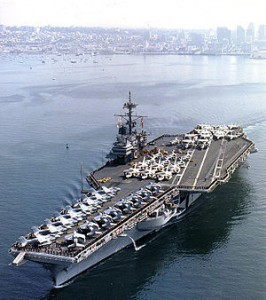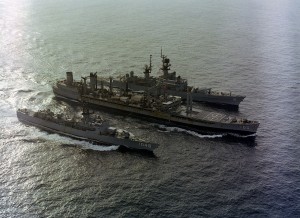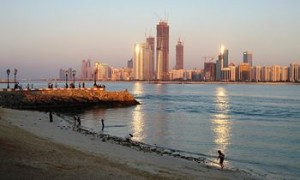Archive Monthly Archives: September 2014
Tell me a Sea Story
Welcome back to Two Navy Guys and a Novel, the site where you can watch over our virtual shoulders as two ex-Navy guys try to write a military thriller. New to the site? Get caught up on all the back episodes here.
This week, JR tells us a sea story about his time as a junior officer onboard the USS RANGER, an aircraft carrier.
Life at sea can be boring—very boring. And then there are the times when it is anything but mundane.
USS RANGER, August 1992
Imagine pulling into Pusan, Korea, as part of the crew of an aircraft carrier. During the transit across the frigid North Pacific Ocean, the ship was flown over by two Russian BEAR reconnaissance aircraft – the first time that had happened in years. When you see how big those Russian aircraft are, and how fast they fly, you realize that for all the talk of a less-capable Russia, they’re still a force to be reckoned with.
But why worry? This was our second port call in as many weeks (we had stopped in Yokosuka, Japan, the week before). I was twenty-something, single and enjoying the shopping, sight-seeing, and great food in Korea. This Navy life was great!
My First Alert Order
That all changed when we got emergency orders to get back underway. Destination: the Persian Gulf. I waved “Hello” and “Good-bye” to Hong Kong and Singapore as we sailed past them. They were on our port call schedule as part of a planned WESTPAC cruise, but skipped now due to the latest uproar caused by Saddam Hussein.
It was only two years since the end of the First Gulf War and Saddam was launching military attacks on the Shiite population in the southern half of Iraq, an action prohibited under a UN Resolution. While the world debated what to do about it, the operational tempo on RANGER went into high gear as we prepared for our mission in the Persian Gulf.
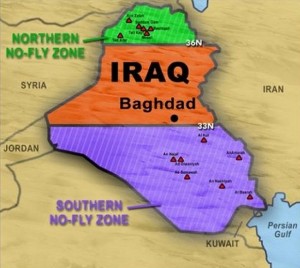 Operation SOUTHERN WATCH established a no-fly zone over the southern half of Iraq to prevent Saddam Hussein from using air power against his own people. The big risk to the operation was a very real danger that Saddam might try to engage the U.S. Navy jets, kicking off another full-blown shooting war.
Operation SOUTHERN WATCH established a no-fly zone over the southern half of Iraq to prevent Saddam Hussein from using air power against his own people. The big risk to the operation was a very real danger that Saddam might try to engage the U.S. Navy jets, kicking off another full-blown shooting war.
My job was in the Carrier Intelligence Center, or CVIC, where we helped pilots plan their missions and then debriefed them when they returned. As you might imagine, the “pucker factor” was pretty high as we started flight operations. Nobody wanted to be the guy who started another Gulf War, but at the same time, getting shot down over Iraq was not a fun option. As an intelligence officer, I was on the “pointy end” of U.S. foreign policy, trying to keep policy makers aware of what was actually going on in the air over Iraq. Mostly that entailed debriefing pilots and merging all their individual observations into reports.
How Do You Feed a Fleet?
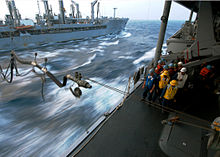 It takes a massive amount of supplies to feed 5,500 sailors and keep 85 aircraft flying, not to mention the fuel needed to keep the engines running on a conventionally-powered aircraft carrier. At sea, the Navy uses underway replenishment, or UNREPS, to do “on the go” resupply operations. Roughly once a week, a supply ship steams alongside the carrier, lines and hoses are slung between the ships, and the supply ship transfers fuel, food, and other sundries over the open water. Sometimes, they even transfer people! It’s a very dangerous operation, but a necessity to allow a navy ship to stay on station. If you think this sounds easy, check out the above picture. These ships are moving!
It takes a massive amount of supplies to feed 5,500 sailors and keep 85 aircraft flying, not to mention the fuel needed to keep the engines running on a conventionally-powered aircraft carrier. At sea, the Navy uses underway replenishment, or UNREPS, to do “on the go” resupply operations. Roughly once a week, a supply ship steams alongside the carrier, lines and hoses are slung between the ships, and the supply ship transfers fuel, food, and other sundries over the open water. Sometimes, they even transfer people! It’s a very dangerous operation, but a necessity to allow a navy ship to stay on station. If you think this sounds easy, check out the above picture. These ships are moving!
A carrier like the USS RANGER displaces 56,000 tons (which is small for a modern aircraft carrier) and is over 1000 feet long. At around 700 feet, supply ships aren't small either. It’s an amazing sight to watch the discipline that goes into an UNREP and how fast supplies are transferred between these two massive ships. Trust me, neither ship wants to be tethered together one second longer than is necessary.
Port call!
We spent 54 days operating at this tempo. When it became obvious Saddam was not going to restart the First Gulf War, we got word that RANGER would be rewarded with a port call in Abu Dhabi. But, the port call was really just an excuse to perform a complete resupply of the ship in a time efficient manner so we could get back to sea.
We pulled into Abu Dhabi for five days. While the ship did a full stores load, I spent about 18 hours each day sleeping, in an EXPENSIVE hotel bed, just to regenerate my internal batteries. When I wasn't sleeping, I would walk in a straight line for longer than 1,000 feet, the absolute limit of how far I could walk on the RANGER.
The rest of the time I spent looking at the desert. It was mentally refreshing to see a different color after almost two months at sea. The only colors you really see on an aircraft carrier are the gray steel of the ship and the slate-blue of the ocean, and your mind becomes starved for new color inputs. By contrast, the desert was filled with rich browns and golds.
Then, we were underway again.
Back In The Saddle
Such is the life of an intelligence officer aboard a warship. The thing I wasn’t ready for when we first deployed was the sleep deprivation. Pilots get to sleep for a minimum of eight hours each night – “crew rest,” they call it– or they're grounded. It makes sense. You don’t want a tired pilot trying to fly a $50M aircraft off a moving ship (not to mention trying to land again). It’s not safe for the pilot or the ship.
The rest of the ship didn’t have rules about minimum rest. My non-flying shipmates and I got about four hours of sleep each day. Not all at one time, mind you. Four hours, per day, in cat-naps of two or so hours – at least as we ramped up for SOUTHERN WATCH. Once operations became more routine, we were finally able to get more like six hours of sleep, and sometimes even in the same stretch!
Just a taste of what life is like as a junior officer aboard an aircraft carrier, and a true story about part of my first deployment between August 1992 and January 1993 aboard USS RANGER.

